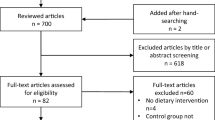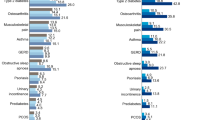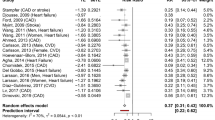Abstract
Objective:
To analyze whether two dietary weight loss interventions—the dietary approaches to stop hypertension (DASH) program and a low-fat diet program— would be cost-effective in Australia, and to assess their potential to reduce the disease burden related to excess body weight.
Design:
We constructed a multi-state life-table-based Markov model in which the distribution of body weight influences the incidence of stroke, ischemic heart disease, hypertensive heart disease, diabetes mellitus, osteoarthritis, post-menopausal breast cancer, colon cancer, endometrial cancer and kidney cancer. The target population was the overweight and obese adult population in Australia in 2003. We used a lifetime horizon for health effects and costs, and a health sector perspective for costs. We populated the model with data identified from Medline and Cochrane searches, Australian Bureau of Statistics published catalogues, Australian Institute of Health and Welfare, and Department of Health and Ageing.
Outcome measures:
Disability adjusted life years (DALYs) averted, incremental cost-effectiveness ratios (ICERs) and proportions of disease burden avoided. ICERs under AUS$50 000 per DALY are considered cost-effective.
Results:
The DASH and low-fat diet programs have ICERs of AUS$12 000 per DALY (95% uncertainty range: Cost-saving—68 000) and AUS$13 000 per DALY (Cost-saving—130 000), respectively. Neither intervention reduced the body weight-related disease burden at population level by more than 0.1%. The sensitivity analysis showed that when participants’ costs for time and travel are included, the ICERs increase to AUS$75 000 per DALY for DASH and AUS$49 000 per DALY for the low-fat diet. Modest weight loss during the interventions, post-intervention weight regain and low participation limit the health benefits.
Conclusion:
Diet and exercise interventions to reduce obesity are potentially cost-effective but have a negligible impact on the total body weight-related disease burden.
This is a preview of subscription content, access via your institution
Access options
Subscribe to this journal
Receive 12 print issues and online access
$259.00 per year
only $21.58 per issue
Buy this article
- Purchase on Springer Link
- Instant access to full article PDF
Prices may be subject to local taxes which are calculated during checkout
Similar content being viewed by others
References
Flegal KM, Graubard BI, Williamson DF, Gail MH . Excess deaths associated with underweight, overweight, and obesity. Jama 2005; 293: 1861–1867.
Peeters A, Barendregt JJ, Willekens F, Mackenbach JP, Al Mamun A, Bonneux L . Obesity in adulthood and its consequences for life expectancy: a life-table analysis. Ann Intern Med 2003; 138: 24–32.
Haslam DW, James WP . Obesity. Lancet 2005; 366: 1197–1209.
James WP, Jackson-Leach R, Ni Mhurchu C, Kalamara E, Shayeghi M, Rigby NJ et al. Overweight and obesity (high body mass index). In: Ezzati M, Lopez AD, Rodgers A, Murray CJL (eds). Comparative quantification of health risks vol. 1. World Health Organization: Geneva, 2004. pp 497–596.
Cameron AJ, Welborn TA, Zimmet PZ, Dunstan DW, Owen N, Salmon J et al. Overweight and obesity in Australia: the 1999–2000 Australian Diabetes, Obesity and Lifestyle Study (AusDiab). Med J Aust 2003; 178: 427–432.
Begg S, Vos T, Barker B, Stevenson C, Stanley L, Lopez AD . The Burden of Disease and Injury in Australia. AIHW: Canberra, 2007.
Colagiuri S, Lee CM, Colagiuri R, Magliano D, Shaw JE, Zimmet PZ et al. The cost of overweight and obesity in Australia. Med J Aust 2010; 192: 260–264.
Franz MJ, VanWormer JJ, Crain AL, Boucher JL, Histon T, Caplan W et al. Weight-loss outcomes: a systematic review and meta-analysis of weight-loss clinical trials with a minimum 1-year follow-up. J Am Diet Assoc 2007; 107: 1755–1767.
Wing RR . Physical activity in the treatment of the adulthood overweight and obesity: current evidence and research issues. Med Sci Sports Exerc 1999; 31 (Suppl 11): S547–S552.
Rucker D, Padwal R, Li SK, Curioni C, Lau DC . Long term pharmacotherapy for obesity and overweight: updated meta-analysis. Bmj 2007; 335: 1194–1199.
Maggard MA, Shugarman LR, Suttorp M, Maglione M, Sugarman HJ, Livingston EH et al. Meta-analysis: surgical treatment of obesity. Ann Intern Med 2005; 142: 547–W-118.
Carter R, Vos T, Moody M, Haby MM, Magnus A, Mihalopoulos C . Priority setting in health: origins, description and application of the Australian assessing the cost-effectiveness of prevention initiative. Expert Rev Pharmacoeconomic Outcomes Res 2008; 8: 593–617.
Cobiac LJ, Vos T, Barendregt JJ . Cost-effectiveness of interventions to promote physical activity: a modelling study. PLoS Med 2009; 6: e1000110.
Cobiac L, Vos T, Doran C, Wallace A . Cost-effectiveness of interventions to prevent alcohol-related disease and injury in Australia. Addiction 2009; 104: 1646–1655.
Sacks G, Veerman JL, Moodie M, Swinburn B . ‘Traffic-light’ nutrition labelling and ‘junk-food’ tax: a modelled comparison of cost-effectiveness for obesity prevention. Int J Obes (Lond); E-pub ahead of print 16 November 2010; doi: 10.1038/ijo.2010.228.
Dansinger ML, Tatsioni A, Wong JB, Mei C, Balk EM . Meta-analysis: the effect of dietary counseling for weight loss. Ann Intern Med 2007; 147: 41–W7.
Appel L . Effects of comprehensive lifestyle modification on blood pressure control: main results of the premier clinical trial. JAMA 2003; 289: 2083–2093.
Sacks FM, Obarzanek E, Windhauser MM, Svetkey LP, Vollmer WM, McCullough M et al. Rationale and design of the Dietary Approaches to Stop Hypertension trial (DASH) : A multicenter controlled-feeding study of dietary patterns to lower blood pressure. Ann Epidemiol 1995; 5: 108–118.
Svetkey LP, Harsha DW, Vollmer WM, Stevens VJ, Obarzanek E, Elmer PJ et al. Premier: a clinical trial of comprehensive lifestyle modification for blood pressure control: rationale, design and baseline characteristics. Ann Epidemiol 2003; 13: 462–471.
Hollis JF, Gullion CM, Stevens VJ, Brantley PJ, Appel LJ, Ard JD et al. Weight Loss During the Intensive Intervention Phase of the Weight-Loss Maintenance Trial. Am J Prev Med 2008; 35: 118–126.
Swinburn BA, Metcalf PA, Ley SJ . Long-term (5-year) effects of a reduced-fat diet intervention in individuals with glucose intolerance. Diabetes Care 2001; 24: 619–624.
Barendregt JJ, Van Oortmarssen GJ, Van Hout BA, Van Den Bosch JM, Bonneux L . Coping with multiple morbidity in a life table. Math Popul Stud 1998; 7: 29–49, 109.
Barendregt JJ, Van Oortmarssen GJ, Vos T, Murray CJ . A generic model for the assessment of disease epidemiology: the computational basis of DisMod II. Popul Health Metr 2003; 1: 4.
Haby M, Markwick A . Future prevalence of overweight and obesity in Australian children and adolescents, 2005-2025. Public Health Branch, Victorian Government Department of Human Services: Melbourne, 2008.
Barendregt JJ, Veerman JL . Categorical versus continuous risk factors and the calculation of potential impact fractions. J Epidemiol Community Health 2010; 64: 209–212.
Ni Mhurchu C, Parag V, Nakamura M, Patel A, Rodgers A, Lam TH . Body mass index and risk of diabetes mellitus in the Asia-Pacific region. Asia Pac J Clin Nutr 2006; 15: 127–133.
Dale KS, McAuley KA, Taylor RW, Williams SM, Farmer VL, Hansen P et al. Determining optimal approaches for weight maintenance: a randomized controlled trial. CMAJ 2009; 180: E39–E46.
Freedman MR, King J, Kennedy E . IV. Weight Maintenance. Obesity 2001; 9: 33S–34S.
Australian Institute of Health and Welfare. Health Expenditure Australia. Australian Institute of Health and Welfare: Canberra, 2008.
Australia Bureau of Statistics. Consumer Price Index vol. Cat No. 6401.0. Australian Bureau of Statistics: Canberra.
Jacobs P, Fassbender K . The measurement of indirect costs in the health economics evaluation literature. A review. Int J Technol Assess Health Care 1998; 14: 799–808.
Australia Bureau of Statistics. Average Weekly Earnings vol. Cat No. 6302.0. Australian Bureau of Statistics: Canberra, 2005.
van Baal PHM, Polder JJ, de Wit GA, Hoogenveen RT, Feenstra TL, Boshuizen HC et al. Lifetime medical costs of obesity: prevention no cure for increasing health expenditure. PLoS Med 2008; 5: e29.
Ezzati M, Lopez AD, Rogers A, Murray CJL . Comparative Quantification of Health Risks. World Health Organisation: Geneva, 2003.
Lipscomb J . Time preference for health in cost-effectiveness analysis. Medical Care 1989; 27: S233–S252.
George B, Harris A, Mitchell A . Cost-effectiveness analysis and the consistency of decision making: evidence from pharmaceutical reimbursement in australia (1991 to 1996). Pharmacoeconomics 2001; 19: 1103–1109.
Cobiac LJ, Vos T, Veerman JL . Cost-effectiveness of Weight Watchers and the Lighten Up to a Healthy Lifestyle program. Australian & New Zealand Journal of Public Health 2010; 34: 240–247.
van Baal PH, van den Berg M, Hoogenveen RT, Vijgen SM, Engelfriet PM . Cost-effectiveness of a low-calorie diet and orlistat for obese persons: modeling long-term health gains through prevention of obesity-related chronic diseases. Value Health 2008; 11: 1033–1040.
Roux L, Kuntz KM, Donaldson C, Goldie SJ . Economic evaluation of weight loss interventions in overweight and obese women. Obesity (Silver Spring) 2006; 14: 1093–1106.
Avenell A, Broom J, Brown TJ, Poobalan A, Aucott L, Stearns SC et al. Systematic review of the long-term effects and economic consequences of treatments for obesity and implications for health improvement. Health Technol Assess 2004; 8: iii–iiv, 1–182.
Gustafson A, Khavjou O, Stearns SC, Keyserling TC, Gizlice Z, Lindsley S et al. Cost-effectiveness of a behavioral weight loss intervention for low-income women: the Weight-Wise Program. Prev Med 2009; 49: 390–395.
Neovius M, Narbro K . Cost-effectiveness of pharmacological anti-obesity treatments: a systematic review. Int J Obes (Lond) 2008; 32: 1752–1763.
Stevens J, Cai J, Pamuk ER, Williamson DF, Thun MJ, Wood JL . The effect of age on the association between body-mass index and mortality. N Engl J Med 1998; 338: 1–7.
Calle EE, Thun MJ, Petrelli JM, Rodriguez C, Heath Jr CW . Body-mass index and mortality in a prospective cohort of US adults. N Engl J Med 1999; 341: 1097–1105.
Adams KF, Schatzkin A, Harris TB, Kipnis V, Mouw T, Ballard-Barbash R et al. Overweight, obesity, and mortality in a large prospective cohort of persons 50 to 71 years old. N Engl J Med 2006; 355: 763–778.
Flegal KM, Graubard BI, Williamson DF, Gail MH . Cause-specific excess deaths associated with underweight, overweight, and obesity. Jama 2007; 298: 2028–2037.
Lavie CJ, Milani RV, Artham SM, Patel DA, Ventura HO . The obesity paradox, weight loss, and coronary disease. Am J Med 2009; 122: 1106–1114.
Chisholm D, Doran C, Shibuya K, Rehm J . Comparative cost-effectiveness of policy instruments for reducing the global burden of alcohol, tobacco and illicit drug use. Drug Alcohol Rev 2006; 25: 553–565.
Jain A . Treating obesity in individuals and populations. Bmj 2005; 331: 1387–1390.
Stinnett AA, Paltiel AD . Estimating CE ratios under second-order uncertainty: the mean ratio versus the ratio of means. Med Decis Making 1997; 17: 483–489.
Drummond MF, Sculpher MJ, Torrance GW, O’Brien BJ, Stoddard GL . Methods for the Economic Evaluation of Health Care Programmes. Oxford University Press: Oxford, 2005. pp 256–258.
Acknowledgements
We would like to thank Health Department partners in the research as well as the input of the ACE Prevention Steering Committee and Technical Groups. This research was funded by an Australian National Health and Medical Research Council Health Services Research Grant (no. 351558). The funders had no role in the study's design, conduct and reporting. The funders had no role in the study's design, conduct and reporting.
Author information
Authors and Affiliations
Corresponding author
Ethics declarations
Competing interests
The authors declare no conflict of interest.
Additional information
Supplementary Information accompanies the paper on International Journal of Obesity website
Supplementary information
Rights and permissions
About this article
Cite this article
Forster, M., Veerman, J., Barendregt, J. et al. Cost-effectiveness of diet and exercise interventions to reduce overweight and obesity. Int J Obes 35, 1071–1078 (2011). https://doi.org/10.1038/ijo.2010.246
Received:
Revised:
Accepted:
Published:
Issue Date:
DOI: https://doi.org/10.1038/ijo.2010.246
Keywords
This article is cited by
-
The health and economic impact and cost effectiveness of interventions for the prevention and control of overweight and obesity in Kenya: a stakeholder engaged modelling study
Cost Effectiveness and Resource Allocation (2023)
-
Modelling the potential health and economic benefits of reducing population sitting time in Australia
International Journal of Behavioral Nutrition and Physical Activity (2022)
-
The moderating effects of mindful eating on the relationship between emotional functioning and eating styles in overweight and obese women
Eating and Weight Disorders - Studies on Anorexia, Bulimia and Obesity (2020)
-
Cost-effectiveness of a community-based cardiovascular disease prevention intervention in medically underserved rural areas
BMC Health Services Research (2019)
-
Untargeted metabolomics identifies a plasma sphingolipid-related signature associated with lifestyle intervention in prepubertal children with obesity
International Journal of Obesity (2018)



